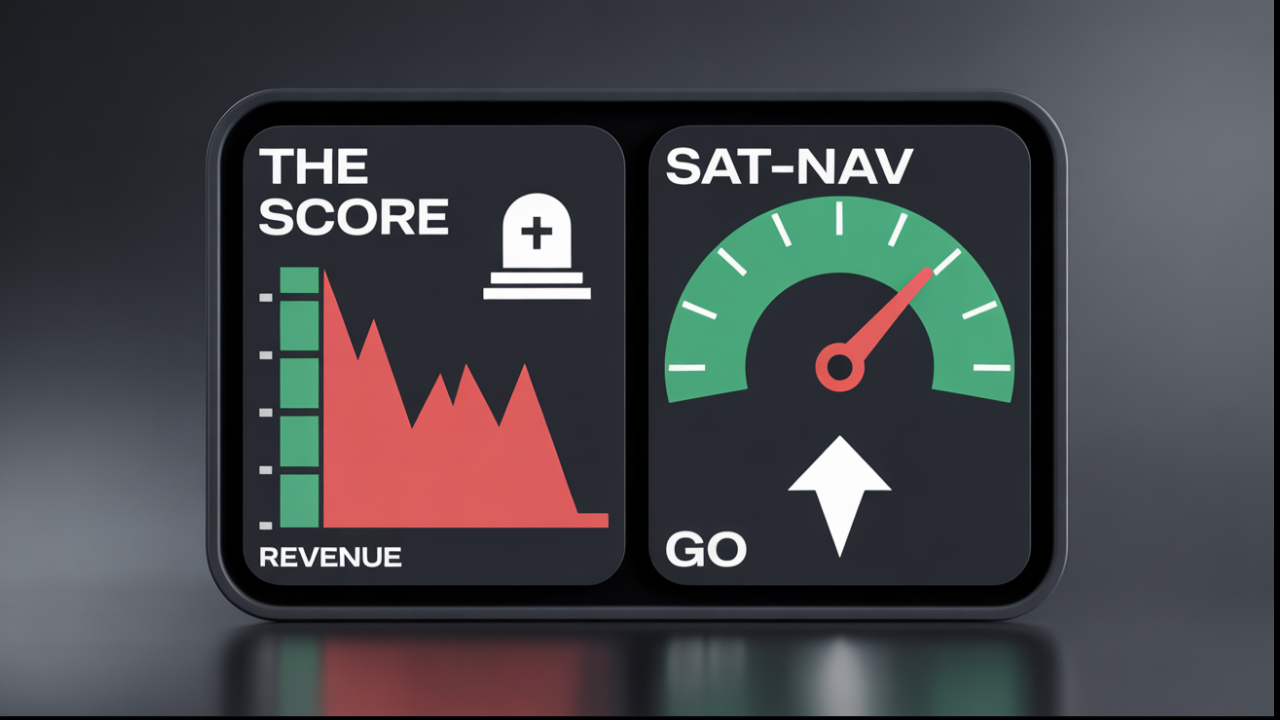Stop Being Busy and Start Being Profitable: A 5-Step Guide to Focusing on What Matters
Take a look at your to do list for this week. Go on, I’ll wait.
Is it a thing of beauty, a streamlined roadmap to success? Or does it look more like a chaotic shopping list written in a panic five minutes before the shop closes? If you’re like most business owners I know, myself included, it’s probably the latter. It’s a sprawling, overwhelming document filled with everything from ‘File VAT return’ and ‘Chase invoice #123’ to ‘Finally figure out what TikTok is’ and ‘Buy more coffee’.
We treat our to do lists like a bucket for every stray thought and obligation that floats through our brains. The result? We feel perpetually busy. We finish the day exhausted, having ticked off a dozen items, but with a nagging feeling that we haven't actually moved the needle. We’ve been running hard, but just to stay in the same place.
This is the classic trap of mistaking activity for achievement. Being busy feels productive, but it often isn’t. It’s a drain on your most precious resources: your time, your focus, and your energy. The real goal, the one that separates struggling businesses from thriving ones, is to focus your efforts on the tasks that genuinely contribute to your bottom line. It’s about being profitable, not just busy. And the path to that clarity starts with a simple, powerful process: auditing your to do list.
Why Bother Auditing Your List? It’s Just a List, Right?
I used to think my to do list was just a tool to not forget things. But over time, I realised it was actually dictating my days. And it was a terrible boss. It was reactive, disorganised, and had no sense of priority. My list was filled with other people’s emergencies and low value admin tasks that felt urgent but weren't important at all.
An audit helps you reclaim control. It forces you to pause and ask the most important question a business owner can ask: “Is this task actually making my business stronger, more profitable, or more resilient?”
When you audit your list, you’re not just organising tasks. You’re making strategic decisions. You’re consciously separating the wheat from the chaff, the revenue generating activities from the time sucking busywork. This isn't about finding more hours in the day. It’s about making the hours you have count for more.
The goal is to get to a point where, every single morning, you know exactly what your top one to three priorities are. Not the tasks that are shouting the loudest, but the ones that align with your core business objectives. The ones that will actually pay the bills, win you new clients, and build the business you dream of. It’s about shifting from a reactive firefighter to a proactive architect of your own success.
The 5 Step Guide to Auditing Your To Do List for Profit
Alright, let’s get practical. This isn’t some abstract theory. It’s a step-by-step process you can do right now with a pen and paper or your favourite digital tool. Grab a cuppa, find a quiet half hour, and let’s dive in.
Step 1: Capture Everything. And I Mean Everything.
First, you need to get it all out of your head. This is the brain dump phase. Don’t filter, don’t judge, don’t organise. Just write. Every single task, project, idea, or obligation that’s currently taking up mental real estate needs to go down on the page.
- Open a fresh document, a spreadsheet, or a new page in your notebook.
- List out all your work tasks. The big projects and the tiny, two-minute emails.
- Include the personal stuff that clutters your mind during the workday, like ‘Book dentist appointment’ or ‘Research summer holidays’. They take up bandwidth, so they belong on the list for now.
- Look through your email inbox, your Slack messages, your calendar. What have you promised to do? What deadlines are looming? Add them to the master list.
The goal here is to create a complete, unvarnished inventory of your commitments. It will probably look terrifying. That’s okay. In fact, it’s good. Seeing it all in one place is the first step to taming it.
Step 2: Identify the Money Makers
Now, with your monster list in front of you, it’s time to play treasure hunter. Go through the list item by item and highlight or tag every single task that directly contributes to profit.
What does that mean? Think about tasks like:
- Sending a proposal to a new lead.
- Making a sales call.
- Following up with a potential client.
- Working on a client project that you will bill for.
- Developing a new product or service you can sell.
Next, identify the tasks that support these money making activities. These are also high value. This could be things like:
- Writing a blog post that attracts your ideal customer (like this one!).
- Creating content for your marketing channels.
- Strategic planning for the next quarter.
- Building relationships with potential partners or referrers.
These might not have an immediate pound sign next to them, but they are the engine of future growth. They build your brand, generate leads, and create leverage. Be generous here. If you can draw a clear line from the task to revenue, now or in the future, mark it as high impact.
Step 3: Evaluate and Classify Everything Else
You should now have a list with a bunch of highlighted, high value tasks. But what about everything else? This is where we get a bit more methodical. For every remaining task, you're going to ask a few simple questions to determine its true value.
You could even create a simple matrix or a scoring system. Ask yourself:
- Financial Return: Does this task make money, save money, or prevent losing money? (High/Medium/Low)
- Time vs. Outcome: Will the result of this task be worth the time I spend on it? Is a two hour task going to deliver more value than four half hour tasks?
- Goal Alignment: Does this task move me closer to my big picture business goals for this year? (Yes/No)
- Urgency: Is there a genuine, hard deadline for this? Or does it just feel urgent?
- Skill Required: Am I the only person who can do this? Or could someone else do it, maybe even better than me?
This is where you have to be brutally honest. That custom report you spend three hours on every month, does anyone actually read it? That networking event you feel obliged to attend, has it ever led to a real opportunity? This evaluation isn't about making you feel bad. It's about bringing awareness to where your time is really going.
Step 4: The Great Elimination (and Delegation)
This is my favourite part. It’s where you get to be ruthless. Based on your evaluation in Step 3, you’re going to sort the remaining low value tasks into three buckets: Eliminate, Delegate, or Automate.
- Eliminate: These are the tasks that provide little to no value. They are habits, not necessities. The reports nobody reads, the meetings that could have been an email, the endless social media scrolling disguised as ‘research’. Just delete them. Cross them off. The feeling of liberation is incredible. It’s also where you learn to start saying “no” to new requests that don’t align with your goals.
- Delegate: Look at the tasks that need to be done, but not necessarily by you. Think bookkeeping, scheduling, social media posting, chasing invoices. These are perfect for a virtual assistant, a freelancer, or a junior team member. Yes, it costs money. But what is your time worth? If you can pay someone £25 an hour to do a task that frees you up to do a £200 an hour task, that’s not a cost. It’s an investment.
- Automate: What repetitive tasks do you do every single week? Sending invoice reminders? Sorting emails? Posting to social media? There are brilliant, often inexpensive, tools that can do this for you. Think Zapier, Xero, Buffer, or even simple email filters. Set it up once, and let the robots do the busywork.
Step 5: Reprioritise and Schedule Your Profitable To Dos
You've done it. You’ve culled the list. What’s left should be a much shorter, more powerful list of high impact, profitable activities. Now, you need to build your week around them.
The biggest mistake people make is trying to fit their most important work into the gaps between meetings and emails. You need to flip that on its head.
- Protect Your Prime Time: Identify your most productive hours. Are you a morning person? Block out 9am to 11am every single day for your most important task. No emails, no calls, no distractions. This is your "deep work" time.
- Use Time Blocking: Instead of a simple list, schedule your tasks directly into your calendar. ‘9-10am: Write proposal for Client X’. ‘10-10:30am: Follow up with 3 warm leads’. This turns your intention into a concrete plan.
- Review Weekly: This isn’t a one time fix. Your priorities will shift. Set aside 30 minutes every Friday afternoon or Monday morning to repeat a mini version of this audit. What worked last week? What new priorities have emerged? This keeps your focus sharp and prevents the clutter from creeping back in.
Staying on Track and Avoiding the Busywork Relapse
Turning this into a habit is the final piece of the puzzle. A few things have really helped me make this stick.
First, use tools that give you clarity. A simple Trello or Asana board with columns for ‘To Do’, ‘Doing’, and ‘Done’ can be revolutionary. You can add labels for ‘High Impact’ or ‘Revenue Generating’ to keep those priorities visually front and centre.
Second, reflect on your outcomes. At the end of the week, don’t just look at what you ticked off. Look at what you achieved. Did you move a big project forward? Did you land a new client? Celebrate those wins. It reinforces the value of focusing on what matters.
Finally, consider some form of accountability. This could be a
business coach, a mentor, or even a trusted peer. Just having someone to check in with, who will ask you “Did you focus on your priorities this week?” can be incredibly powerful for keeping you honest. It’s easy to slip back into old habits, but an external perspective can be the nudge you need to stay on the profitable path.
It took me years to understand that my to do list wasn't just a list. It was a reflection of my priorities, my focus, and ultimately, my potential for success. By taking the time to audit it, to question every item on it, you’re not just cleaning up a document. You’re redesigning your business from the inside out. You’re making a conscious choice to stop being busy and start being profitable. And that’s a choice that will pay dividends for years to come.
Additional Resources:
For further material on related topics, consider exploring the following:
Break Free from the Busywork—Find Your Clear, Proven Path to Business Growth
Stop spinning your wheels and start seeing real progress with the Pathfinder Growth Programme. In just 12 weeks, we’ll cut through the noise, strip away overwhelm, and give you a focused roadmap tailored to your business.
Work side-by-side with your dedicated strategist, gain powerful tools like the Pathfinder Growth Canvas, and finally know the three things that actually move your business forward each week. No more guessing—just clarity, confidence, and growth.
Message Us: Contact Form
Phone: 0330 311 2820
We look forward to helping you discover your unique path to growth, strategies that fit you - not the other way round.
Pay It Forward! Sharing Is Caring!











